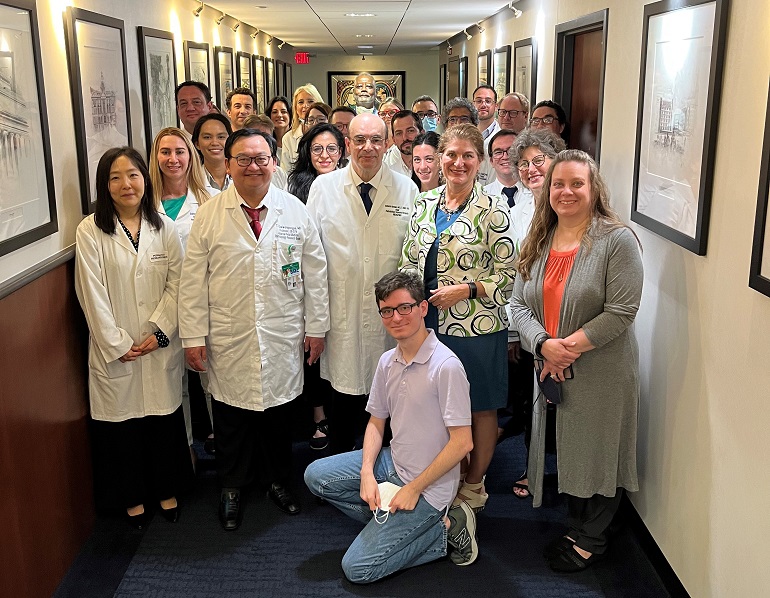
Preeclampsia is a life-threatening hypertensive disorder affecting 300,000 pregnant women in the U.S. annually, often resulting in serious complications and long-term effects for mother and baby.
Eleni Tsigas, is a survivor of the disorder, is chief executive officer of the Preeclampsia Foundation, an organization that for years has funded preeclampsia research at the Perinatology Research Branch of the Eunice Kennedy Shriver National Institute for Child Health and Development of the National Institutes of Health at Wayne State University’s School of Medicine.

The branch hosted “Re-connecting with Preeclampsia: The Preeclampsia Foundation at the Perinatology Research Branch and Department of Obstetrics and Gynecology at Wayne State University” on July 6.
The event was organized and hosted by the PRB, with leadership from Roberto Romero, M.D., D.Med.Sci., who welcomed a packed crowd of PRB researchers, faculty and Preeclampsia Foundation staff and supporters. Dr. Romero is chief of the Perinatology Research Branch, and professor of Molecular Obstetrics and Genetics at the WSU School of Medicine.
Dr. Romero, a member of the Preeclampsia Foundation’s Medical Advisory Board, presented “Preeclampsia: The Conceptual Evolution of an Obstetrical Syndrome.”
“The Preeclampsia Foundation is a very visible national organization devoted to patient advocacy and care as well as practice improvement in maternal health,” he said.
Detroit was one of 24 cities on the “Re-Connect Tour: Putting Preeclampsia on the Map.” Tsigas and a small staff kicked off the 17-state road trip June 2, traveling in a recreational vehicle for two months to meet preeclampsia survivors, donors, researchers, clinicians and supporters in the Midwest and eastern United States.
“Dr. Romero has done a lot,” Tsigas said. “He has been a big proponent of the foundation. We’re more than just a subject in a research study. We’re not just another patient on the other side of the stirrups.”
Other presentations, all from School of Medicine researchers, included “The Story of the Top Image of Preeclampsia in Google,” “Angiogenic and Anti-angiogenic Factors,” “Proteomics of Early and Late Preeclampsia” and “The Placenta in Preeclampsia.”
“It was a great opportunity to stop here,” Tsigas said. “It is a privilege to be able to come here, and to see a roomful of scientists at Wayne State who care about this topic is really heartwarming.”
On the tour, she also is meeting with foundation supporters, survivor families and their children, and hosting community events and fundraising walks. The foundation funds studies to gain better insight into how to diagnose, treat and eventually prevent the disorder. Her 22-year-old son Jordan, with whom she survived preeclampsia, joined her at the Detroit stop.
“These are centers of preeclampsia excellence, and we want to applaud and showcase their innovative and superlative work,” Tsigas said. “This really is one of the great obstetrical dilemmas. It really is fascinating.”
Tsigas advocated for the clinical integration of using biomarkers for treatment, one of several topics discussed during the event.
She encouraged the attendees to utilize the Preeclampsia Registry, an online database hosted by the foundation that uses individual pregnancy experiences and medical information in research studies to discover the causes — and possible cures — of preeclampsia and related hypertensive disorders. The registry has more than 8,000 members and is seeking more maternal experiences from Black, Indigenous, and People of Color communities to ensure they are proportionately represented in the research, she said.
Preeclampsia is 60% more common in Black women than in those of other races and ethnicities. Black women also are three times more likely to die from the disorder. Tsigas noted that 60% of the maternal deaths caused by preeclampsia are preventable.
“These are moms who were in the prime of their lives,” she said. “Behind every one of these numbers was a young, vibrant woman.”
The Preeclampsia Foundation is a U.S.-based 501(c)(3) non-profit organization established in 2000 to improve the outcomes of hypertensive disorders of pregnancy by educating, supporting, and engaging the community, improving health care practices and finding a cure. Tsigas began at the foundation as a volunteer. She has been CEO since 2009. For more information, visit www.preeclampsia.org.